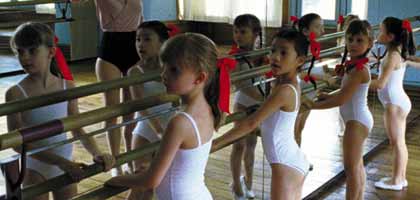
School For Scandal

Dealing with an all-girls' boarding school located in the middle of a dense forest, Lucile Hadzihalilovic's Innocence is like Enid Blyton re-written by Kafka. Jonathan Romney is impressed with its uncanny atmosphere.
The imagery of Lucile Hadzihalilovic's stunning girls'-school fantasia Innocence might make one worry it will appeal to paedophiles, but in fact its mysteries are all about the meaning of innocence itself. By Jonathan Romney
You begin watching Lucile Hadzihalilovic's debut film Innocence with creeping apprehension. It's partly because of the ostentatiously long, eerily flickering opening credits, set not to music but to an ominous submarine rumble. Then a little girl emerges half-naked from a coffin, to be greeted by her peers, all dressed in pristine white uniforms and smiling sweetly - like little Stepford Daughters on a tennis outing. It makes you wonder what kind of world, sinister nightmare or sugar-and-spice dream, Hadzihalilovic has brought you.
It's hardly surprising if dark things are expected of Hadzihalilovic. As partner and collaborator of Gaspar Noé, she edited the two fierce provocations that made his name - the 1991 short Carne and its full-length sequel Seul contre tous (1998) - while he photographed her 52-minute La Bouche de Jean-Pierre (1996), a claustrophobically intense drama about child abuse. Hadzihalilovic had announced that her eagerly awaited first feature would be in the horror genre, but she ended up making another film entirely. If there is horror in Innocence, it is of a dreamlike, fairytale variety - a gothic unease all the more discomforting because it is so hard to pin down.
Innocence is based on 'Mine-Haha, or the Physical Education of Young Girls', a story by German expressionist playwright Frank Wedekind. The film's setting is a boarding school for girls situated in a densely forested estate; the time is unspecified, possibly Wedekind's fin de siècle but just conceivably some period in the 20th century. The pupils, aged roughly from six to puberty, live in five houses, each organised by age group; they tie their hair in ribbons in each colour of the rainbow according to age. There seem to be only two teachers, both young, beautiful and benign: Mlle Edith (Hélène de Fougerolles), who teaches science, and dance instructor Mlle Eva (Marion Cotillard), who might herself have stepped out of a Degas painting.
There is a headmistress but she visits only once a year, to choose a dance pupil to take away with her, according to criteria never explained (apparently less to do with talent than with length of neck, raising sinister overtones of eugenics). Elderly servants staff the houses: they are rumoured to be former pupils who ran away and were punished by being made to work in the school for the rest of their lives.
The atmosphere of uncanny other-worldliness is established from the start as new girl Iris (Zoé Auclair) arrives in her coffin to be welcomed by her housemates, who dress her, give her the red ribbon worn by first years and initiate her into school lore. At first Iris is baffled and a little lost. "But where is my little brother?" she asks. "There are no boys here," explains the house's head girl Bianca (Bérangère Haubruge), who treats Iris with big-sisterly protectiveness. "What is this place?" Iris asks. "Home," Bianca replies.
But it's a home from which there is no escape. On one level the school is idyllic: classes are a source of wonder and delight and free time is spent splashing in a lake or practising gymnastics among the trees. But there are many alarming things here too, notably the mystery of the underground tunnels beneath the estate and the strange sounds emanating from them. When one girl climbs over the perimeter wall, the pupils are told she must never be spoken of again. Another tries to escape by river, in a sequence of quietly virtuoso horror: as her boat fills with water the camera sinks down into turbulent depths, rising again into a stormy night as rain beats down.
The world Hadzihalilovic creates is vividly real but at the same time so systematic it becomes abstract. Governed by its own rigorous laws, the school is organised not only to exclude the outside world but to persuade the pupils to behave as if the outside did not exist, at least while their childhood lasts. This is girls'-school fiction à la Angela Brazil or Enid Blyton rewritten according to the logic of Kafka.
In Britain the genre of girls'-school fiction is customarily treated with suspicion or irony: the tradition of jolly-hockey-sticks larks has been the subject of ridicule for decades, from the St Trinian's films to the stage spoof Daisy Pulls It Off, while the more disreputable uses of the mythology are demonstrated by the recently published panting fetish-fiction of Philip Larkin, Trouble at Willow Gables. But the lack of a comparable French tradition makes it possible for Hadzihalilovic to take the genre innocently, as it were; in fact, she was inspired by her own childhood reading of Enid Blyton's Malory Towers books.
The Blyton cycle is just one of the echoes that make Innocence so uncanny, in the sense of teeming with traces of other texts. There are cinematic overtones of Buñuel, of Borowczyk, of Clouzot's Les Diaboliques, of The Shining, not to mention Mädchen in Uniform (Leontine Sagan, 1931), that German Ur-text of quasi-military dorm sapphism. Hadzihalilovic herself has acknowledged comparisons with Peter Weir's Picnic at Hanging Rock, Víctor Erice's Spirit of the Beehive and Dario Argento's school-set Suspiria. But while Innocence echoes so many other films, there are few that it closely resembles. The most pertinent affinity might be a literary one, with Angela Carter's post-Freudian rewrites of the fairytale canon in The Bloody Chamber. Innocence is a prime example of what Carter called the "menstrual film" - her term for the dream fictions of female adolescence among which she classed Neil Jordan's adaptation of her own story, The Company of Wolves.
Innocence is rich in visual echoes too. Its woodland interludes resemble the artificial idylls created in the 1970s and 1980s by French photographer Bernard Faucon in his tableaux of boys - played by shop-window dummies - enjoying bucolic days out, images made sinister by their inanimate nature. Hadzihalilovic does not recognise Faucon as an influence but does cite American photographer Sally Mann, whose portraits of her own children, sometimes naked, were the subject of bitter controversy. Another reference she names is the Belgian symbolist artist Léon Frédéric (1856-1940): his painting The Lake Dormant Waters, in which naked infants loll among white swans, is as egregious an example of academic kitsch as you could find.
The film's dreamlike quality also derives from its extraordinary stylistic subtlety. Framed in Cinemascope format but photographed in Super-16, Innocence was shot by Benoît Debie using available light, with no indoor light sources other than the lamps we see. The interior lighting is warm and dusty, evoking the brown closeness of dimly remembered schoolrooms, while the forest at night is illuminated by overhead lamps that cast pools of hazy glow. Colours were deepened in digital post-production, enhancing the classical painterly look: particularly beautiful are the nature shots, the still views of the empty park.
But what makes Innocence especially unsettling is its iconography of girlhood. For many viewers, Hadzihalilovic's presentation - indeed, celebration - of her little girls will look like the stuff of paedophile fantasy. Yet the film's title is in no way ironic: this is quite literally a work about innocence. Indeed, it is the very absence of sexual connotation in the film - until its final stages, that is - that strikes us as unexpected, given that artists from Hans Bellmer through Balthus to Paula Rego have accustomed us to look for sinister, sometimes violent associations in the image of the schoolgirl. Hadzihalilovic, by contrast, uses school uniform in an entirely non-connotational light: these little girls, she is telling us, are just little girls - as they used to be in some barely imaginable and arguably mythical era before people thought of worrying about the sexualisation of such images.
Yet while Hadzihalilovic presents girlhood as an asexual or rather presexual state, the film is nevertheless about female sexuality and its development. While the girls' enclosed universe is presexual, the school itself is nothing if not an antechamber to the sexual world of adulthood. Mlle Edith tells her pupils that their eventual destiny is to reproduce: "You must find a partner and ensure his descent." But towards the end of the film, as Bianca's story comes to the fore, we become aware that while the girls are being prepared to put their adult sexuality to the service of the social order, they will also come into possession of their own sexual power and pleasure. A key moment - in a thoroughly eerie setting that I won't give away - comes when the only male voice heard in the film shouts a compliment to Bianca and she responds with an expression combining pride and curiosity, the film's first unmistakably sexual look. This is the prelude to a breathlessly euphoric, entirely unexpected ending that puts the seal on the film's visionary brilliance.
You can expect Innocence to make its mark as a cult favourite, and to inspire film-studies debate for years to come. It is a film that will mean different things to different viewers, depending on gender and, no doubt, on educational background: I'd love to know what former boarding-school girls make of it. Its universe may be the very image of a lost utopia to some female viewers and I suspect it will be disconcerting for many men, for whom the all-girl world will be like a glimpse of an alien planet.
But still you can't help wondering how a paedophile might view the film. You can always argue that a film's effects on a spectator are beyond its maker's control, and that someone so predisposed could get a libidinal thrill from Billy Elliot, or Annie, or Lassie for that matter. It's beyond question, however, that Hadzihalilovic deliberately uses images that were once considered innocuous and are now effectively taboo. If we have a problem with that - as many viewers will - then, she seems to be saying, the problem is ours.
One way or another, though, most viewers will recognise Innocence as a film of exceptional originality that establishes its director-writer as an audacious talent. Among the current class of young French film-makers, Hadzihalilovic is definitely head girl.
